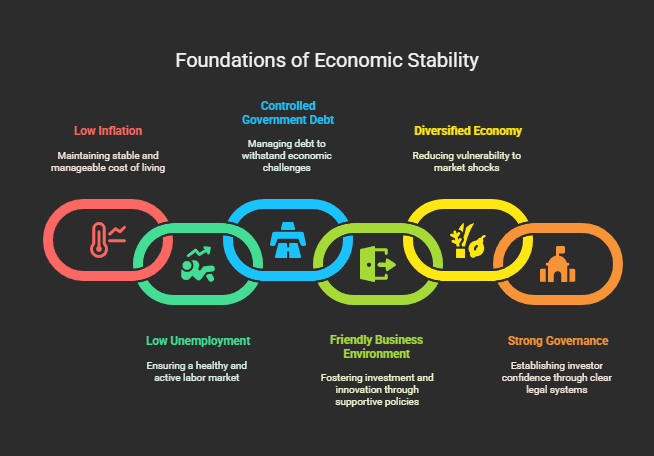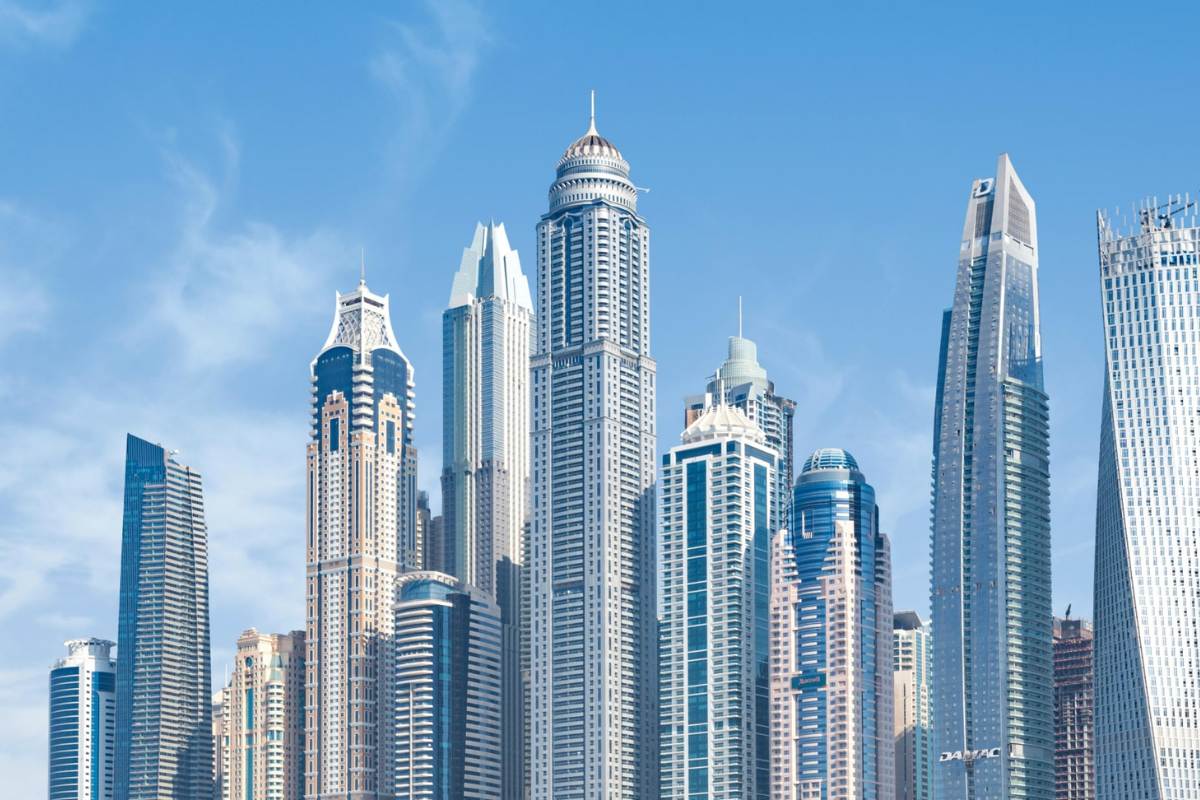The New World Order of Economic Stability: Why the UAE is Number One and the US is out of the Top 10
The world economy is changing. Traditional powers are being challenged by rising economies, and the old measures of economic power are being reconsidered. A new report from US News & World Report has rocked the financial community, naming the United Arab Emirates (UAE) as the most economically stable nation on Earth. This shocking outcome, which leaves the US out of the top ten and India a faraway 47th, raises a question: What is economic stability in the 21st century?
In this detailed examination, we will examine the reasons behind the meteoric growth of the UAE, explore the economic models of the rest of the top-ranked countries, and discuss why some of the globe’s biggest economies are finding it hard to keep up.
Understanding Economic Stability: More Than Just GDP

Before we break down the rankings, it’s important to note what exactly we’re referring to when we say “economic stability.” It’s not merely how big the economy of a country is or its GDP growth rate. Real economic stability is a complex concept that consists of many factors, some of which include:
- Low Inflation: An economy that is stable maintains inflation at a low level so that the cost of living to its people is stable and manageable.
- Low Unemployment: A low rate of unemployment indicates a good and healthy labor market where individuals willing to work are employed.
- Controlled Government Debt: A nation that can control its debt is in a better position to survive economic recessions and invest in the future.
- Friendly Business Environment: Ease of business, low corruption, and business-friendly policies that help investment and innovation.
- Diversified Economy: A nation that is not too dependent on a single sector is more resistant to shocks and volatility in world markets.
- Strong Governance and Rule of Law: A clear and predictable system of law and politics is necessary for establishing investor confidence and long-term stability.
The US News & World Report ranking, which polled 17,000 individuals, including business professionals and the general public, considered these and other variables, evaluating 73 traits in 89 nations. By taking this more holistic approach, it can generate a better picture of economic stability than can be derived solely from conventional measures.
Check out the Top 10 Most Economically Stable Countries:
United Arab Emirates (UAE): The Surprising New Leader
The UAE’s rise to the pinnacle of economic stability rankings is a reflection of its visionary policies and proactive diversification drive. Though the wealth of the country was founded in oil, it has now become successful in diversifying to a more diversified economy with a booming tourism, trade, and finance industry.
Key Strengths:
- Diversification: The UAE has invested significantly in non-oil sectors, mitigating its reliance on unstable energy markets. This has established a more sustainable and robust economic model.
- Business-Friendly Environment: The UAE provides a low-tax, low-regulatory environment that is very appealing to entrepreneurs and foreign investors. Lack of personal income tax and low corporate taxes are significant attractions.
- Infrastructure: The country has invested in world-class infrastructure, including state-of-the-art airports, seaports, and telecommunications networks. This facilitates trade and commerce, making it a global hub for business.
- Political Stability: The UAE’s stable political environment provides a predictable and secure backdrop for economic activity.
Economic Outlook:
The UAE’s economic outlook is still strong, with the IMF and World Bank estimating real GDP growth of approximately 4% in 2025. Inflation will remain steady, while the nation’s non-oil trade continues to expand at a high rate. The UAE’s “We the UAE Vision 2031” vision, which is intended to double the nation’s GDP, will continue to spur growth and development in the future.
Switzerland: The Gold Standard of Stability
Switzerland has been equated with stability for as long as anyone can remember, and its second-place position is hardly a surprise. Its solid banking system, dedication to innovation, and highly trained workforce have built an extremely resilient and affluent economy.
Key Strengths:
- Financial Sector: Switzerland is a world leader in finance and banking, with a reputation for stability, discretion, and security. This has been attractive to huge levels of foreign capital, which have been the drivers of the economic growth of the country.
- Innovation: The nation is home to research and development facilities, as well as an emphasis on high-tech sectors such as pharmaceuticals, biotechnology, and precision engineering.
- Skilled Human Resources: Switzerland possesses an extremely well-educated and skilled human resource base that is critical to fostering innovation and productivity.
- Low Unemployment and Inflation Rates: The nation has one of the lowest unemployment and inflation rates in the world consistently, which is a major factor in achieving a high standard of living for all its citizens.
Economic Outlook
The Swiss economy is likely to experience a return to usual growth in 2025, following a year of muted growth in 2024. Global economic recovery will be lifting demand for Swiss exports, and the nation’s solid fundamentals will help maintain it as a haven for investors.
Germany: The Engine of Europe
Being the biggest economy in Europe, Germany is a manufacturing and export powerhouse globally. The economy has a solid industrial base, an educated labor force, and strict fiscal discipline, making it the economic role model.
Strengths:
- Manufacturing and Exports: Germany is globally dominant in the manufacture of high-quality products, including autos, machinery, and chemicals. The export-based economy of Germany has been one of the major drivers of the country’s economic performance.
- Qualified Workforce: The German dual training system, linking vocational instruction with classroom learning, generates a quality workforce skilled to meet the needs of today’s economy.
- Fiscal Responsibility: The fiscal policy of the German government is noted for being cautious, which has helped to keep the government debt at bay while fostering an economic climate that is stable.
Economic Prospects:
The German economy is presently experiencing some tailwinds, with growth anticipated to be stagnant in 2025. Nevertheless, the near-term perspective is upbeat, as a return to 1.1% growth is predicted for 2026. The government’s proposals to increase expenditure on infrastructure and defense are likely to give the economy a boost, and the nation’s robust fundamentals are likely to keep it as a global economic leader.
Canada: A Stable and Resource-Rich Economy
The combination of Canada’s vast natural resources, stable banking system, and robust trade networks has resulted in a stable and booming economy.
Strong Points:
- Natural Resources: Canada is a significant producer of oil, gas, minerals, and farming products. This has been the basis on which the economic growth of the country is established.
- Stable Banking System: Canada’s banking system has been hailed as one of the most stable globally. That has served to insulate the nation from the unpredictable kind of financial crises that have visited other countries.
- Trade: Canada enjoys robust trade relationships with the United States and other leading economies, which have served to ramp up its exports and jobs.
Economic Outlook:
The Canadian economy is forecast to expand by approximately 1.8% in 2025 and 2026. Decreasing interest rates and increasing incomes are forecast to drive consumer spending, and the nation’s solid export sector will continue to thrive.
Japan: The Technological Titan
Japan is the fourth-largest economy in the world and a leading nation in technology, manufacturing, and innovation. The innovative culture, high-skilled workforce, and strong work ethic of the nation have made it an economic success story.
Major Strengths:
- Technology and Manufacturing: Japan is the global leader in the manufacturing of high-technology products, including electronics, robotics, and automobiles. Japan’s emphasis on research and development has enabled the nation to remain at the cutting edge of innovation.
- Skilled Labor Force: Japan possesses a highly skilled and educated labor force that is needed to push innovation and productivity.
- Strong Work Ethic: The country is renowned for having a strong work ethic and dedication to quality, which has been a driving force in the economic prosperity of the nation.
Economic Outlook:
The Japanese economy is likely to expand at a rate of approximately 1.1-1.2% in 2025. Wage gains are likely to be higher than inflation, thus increasing consumer spending. But the nation has some long-term issues, such as an aging population and a high level of government debt.
Australia: A Resourceful and Resilient Nation
Stable governance and resource abundance have made Australia a wealthy and resilient country.
Key Strengths:
- Natural Resources: Australia is a significant producer of iron ore, coal, and minerals. This has made a strong basis for the economic growth of the country.
- Stable Governance: Australia enjoys a stable and democratic government, which has assisted in establishing a secure and reliable business environment.
- Strong Financial Sector: The financial sector of Australia is highly regulated and robust, which has assisted in shielding the nation from financial crises.
Economic Outlook:
The Australian economy will grow at 1.75% in 2024-2025 and 2.25% in 2025-2026. Domestic consumption will be restrained, but business investment will bounce back. The unemployment rate is likely to increase marginally.
Sweden: The Innovative and Socially Conscious Economy
Sweden’s mix of a high-tech, export-driven economy and a robust social safety net has resulted in an affluent and fair society.
Key Strengths
- Innovation: Sweden is a leader in innovation at the global level, with a high concentration in high-technology industries such as telecommunications and clean energy.
- Strong Social Safety Net: Sweden boasts a robust social welfare system that delivers high social protection to its citizens. This has contributed to a more stable and equitable society.
- Skilled Workforce: Sweden is endowed with a highly skilled and educated workforce, which is critical in spurring innovation and productivity.
Economic Outlook:
Sweden is already in a recession, but an upturn can be expected in the second half of 2025. Higher real wages and reduced interest rates will stimulate household consumption, and the export sector of the country will continue to do well.
Denmark: The Green and Globalized Economy
Denmark’s globalized and open economy, along with its high emphasis on green technology, has made for a successful and sustainable society.
Key Strengths:
- Green Technology: Denmark is the global leader in green technology with a high emphasis on wind power and other renewable energy sources. This has contributed to a more sustainable and eco-friendly economy.
- Open and Globalized Economy: Denmark’s economy is open and globalized with a high emphasis on trade and investment. This has assisted in increasing its exports and generating employment.
- Strong Social Support Systems: Denmark boasts a coherent social welfare system that grants a very high degree of social protection to the population.
Economic Outlook:
The Danish economy is projected to experience a moderation in growth in the short term, as the external demand diminishes. Nevertheless, the long-term perspective is optimistic, and the country’s sound fundamentals, coupled with its emphasis on green technology, are likely to boost growth in the future.
Netherlands: The Trade and Logistics Hub
The Netherlands’ relative strategic location, advanced infrastructure, and favorable business climate have transformed it into a world-class hub for trade and logistics.
Strengths:
- Trade and Logistics: The country has the port of Rotterdam, which is the biggest in Europe. This has positioned it at the forefront of trade and logistics, as well as propelled its economy.
- Sophisticated Infrastructure: The Netherlands boasts a sophisticated infrastructure, with a high density of roads, railways, and waterways. This makes it easy to move goods and people, and hence makes it a suitable place to do business.
- Friendly Business Environment: The Netherlands has a friendly business environment, with a low business tax rate and an extremely well-educated population.
Economic Outlook
The Dutch economy is expected to grow by 1.3% in 2025, driven by strong domestic demand. However, the country’s export sector is facing some headwinds from the global economic slowdown.
Saudi Arabia: The Oil Giant in Transition
The economy of Saudi Arabia is dominated by the oil and gas industry, but the nation is undergoing a dramatic economic shift. The “Vision 2030” initiative plans to diversify the economy, make it less dependent on oil, and provide new opportunities for its citizens.
Strengths:
- Oil and Gas: Saudi Arabia is the largest exporter of oil globally, and this has been the backbone of its economic growth.
- Vision 2030: The “Vision 2030” plan is a visionary and ambitious plan to restructure the Saudi economy. The plan encompasses a variety of initiatives, including building new industries, attracting foreign investment, and enabling women.
- Young and Growing Population: Saudi Arabia enjoys a young and growing population, which is a huge and dynamic labor force.
The Saudi economy is expected to grow by 4.9% in 2025, driven by strong non-oil growth. The “Vision 2030” plan is expected to continue to drive growth and development in the coming years, but the country faces some challenges, including high youth unemployment and a need to further diversify its economy.
The Outliers: Why the US and India Lag Behind
The United States: A Victim of Its Success?
America’s 13th rank in the economic stability report might be surprising to most. Yes, the US is the leading economy of the world and has a high ranking in innovation and technology. Yet, America is also experiencing a range of difficulties, including:
- High Government Debt: The US carries an extremely high level of debt on its government, which might threaten its long-term economic stability.
- Political Polarization: The nation’s intense political polarization has hindered the ability to respond to important economic issues.
- Growing Inequality: The inequality between the wealthy and the poor has increased over the past few years, and this may create social and economic instability.
- Trade Tensions: The US has had a trade war with China, and this has left businesses and investors uncertain.
The US economy will decelerate in 2025, with a growth rate of 1.7%. The future of the country’s economy will be determined by its capacity to overcome these and other challenges.
India: A Land of Contrast
India’s ranking of 47 is a manifestation of the country’s intricate and frequently paradoxical economic situation. Although India is among the world’s most rapidly growing economies, the country is presently confronting a variety of challenges, including:
- High Inflation: Inflation has been a recurring issue in India, which has reduced the purchasing power of customers.
- High Unemployment: India’s unemployment rate is high, especially among youths.
- Bureaucracy and Corruption: Bureaucracy and corruption are significant barriers to business in India, which can discourage foreign investment.
- Infrastructure Gaps: India’s infrastructure is still underdeveloped in numerous areas, which can hamper economic growth.
Even with these difficulties, the Indian economy is expected to increase by 6.5% in FY 2024-25, ranking among the fastest-growing economies globally. The long-run economic prospects of the country will hinge on whether it can overcome its structural issues and build a more inclusive and equitable society.
Conclusion: A New Era of Economic Stability
The US News & World Report’s ranking of the most economically secure nations emphasizes a changing world. The emergence of the UAE and the good showing of other non-traditional economic leaders show that success has no one formula. Nations that diversify their economies, build an environment conducive to business, and invest in human capital are those best poised to succeed in the 21st century.
The US and Indian experience is a reminder that even the biggest and fastest-growing economies in the world are not exempt from instability. In a more interconnected and volatile world, adaptability, innovation, and creating a more resilient and inclusive society will be the ingredients for long-term economic success. The new world order of economic prosperity is not merely wealth and power; it’s about making the future better and more prosperous for everyone.






















